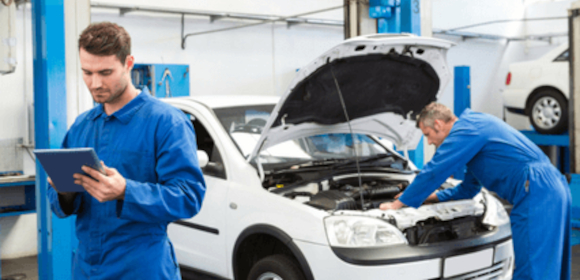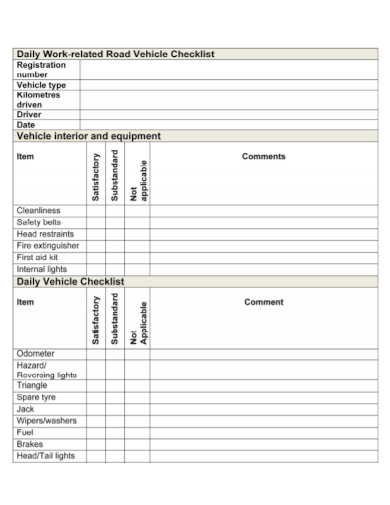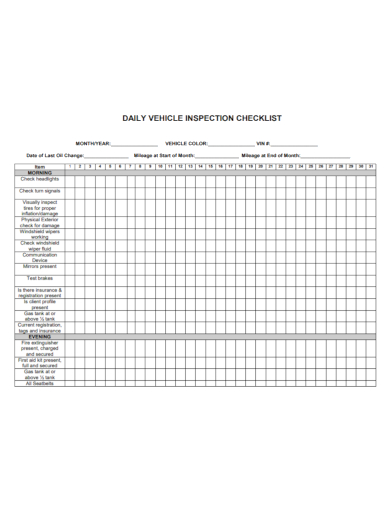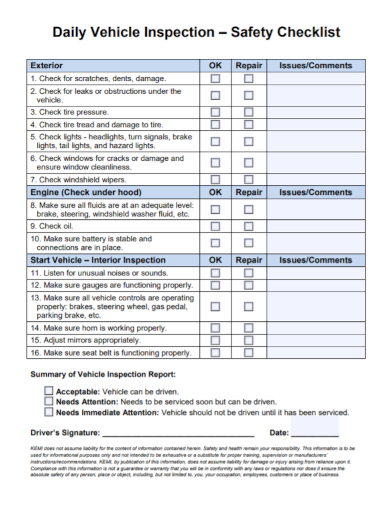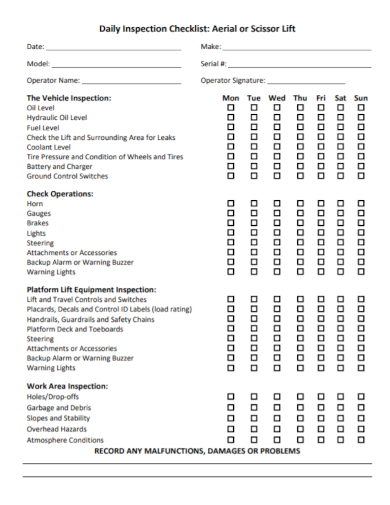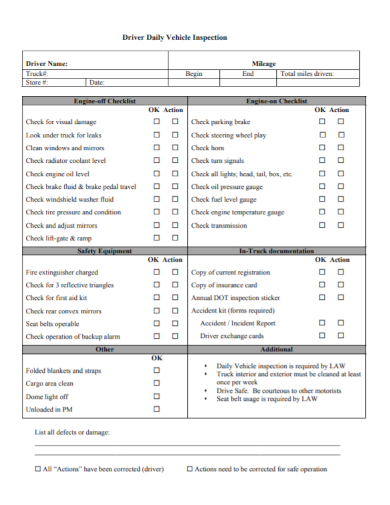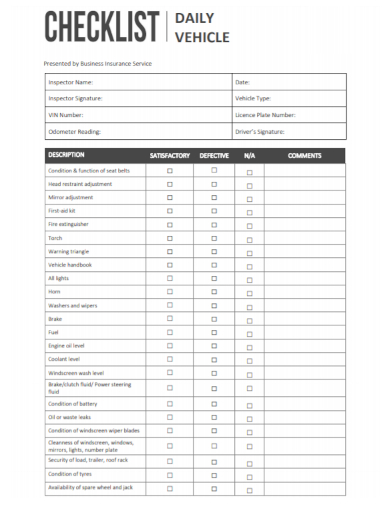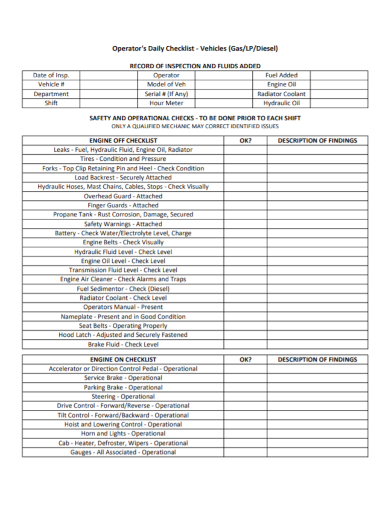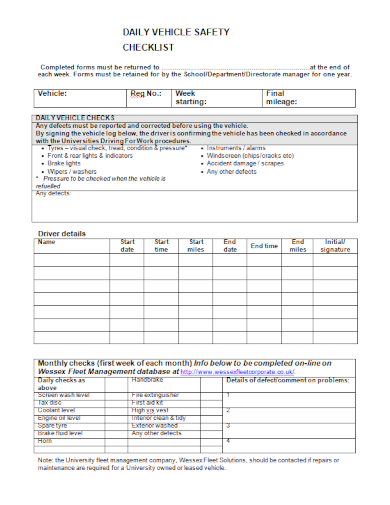If you are a vehicle owner, it is your responsibility to monitor and assess its overall condition. You may even consider visiting a mechanic or a professional inspector who does the inspection for you. The inspector may present a specific checklist provided with a list of items of the defects and mechanical issues that are found in your vehicle. It is also the job of the inspector to provide a recommendation that has the rating of the overall roadworthiness of the vehicle. It does not matter if you have a car or manage a cab service. It is a must to have a vehicle checklist ready. Driving can be one of the most dangerous activity. There have been a lot of reported road accidents per year globally. Accidents may happen due to having a poor driving skills and road condition, mechanical failure, or poor vehicle maintenance.
9+ Daily Vehicle Checklist Samples
1. Daily Vehicle Pre-Start Checklist
2. Daily Work Road Vehicle Checklist
3. Daily Vehicle Inspection Checklist
4. Daily Vehicle Inspection Safety Checklist
5. Vehicle Equipment Daily Inspection Checklist
6. Driver Daily Vehicle Inspection Checklist
7. Daily Vehicle Cleaning Checklist
8. Daily Business Vehicle Checklist
9. Operator Daily Vehicle Checklist
10. Daily Vehicle Safety Checklist
Conducting a preventive maintenance is the key to ensure your safety and your vehicle’s roadworthiness. If you haven’t heard anything about it yet, now is the right time to consider it. When you say “successful operation”, it should mean being there and back in the house safely. The best way to keep your vehicle well-maintained is to understand the potential vulnerabilities.
Daily Vehicle Checklist
Pre-trip:
- Make sure to check the winch and try to see if it is disengaged.
- Before you are going to start the engine, check the wheels and tires for wears and correct pressure and check the fuel, coolant, oil, clutch, brake fluid and battery levels.
- After you start the engine, try to listen if you hear unusual noises.
- Check the other parts that is used to turn on, flash, beep and swish.
- Check if the fuel and oil gauges is still operating.
- Clean your external mirrors, lights and reflectors.
- Check for a spare tire and other changing equipment.
- Adjust the mirror if necessary.
- Check the steering wheel, handbrake, and footbrake.
- You may consider checking your vehicle user handbook in case you have forgotten an item.
- Fix any discrepancies immediately before you are going to start driving.
When you stop:
- Check for any signs of leakage.
- Check the tires.
- Check if it could be possible for an occurrence of overheating.
- Check the stability.
- Check the lights and other indicators.
- Clean the windscreen if necessary.
End of vehicle use:
- Make sure to check the coolant levels.
- Refuel and top up oils and lubricants.
- Check the lights and other indicators.
- It is essential to clean your vehicle also.
- Cleaning means including the interior and load compartment.
- Make sure that the winch is disengaged.
- Complete the other items on the list provided in the vehicle user handbook.
- Fix the deficiencies as soon as possible.
Each time that you get into your vehicle, try to walk around it. You may start on the passenger side going to the driver side. This is one of the best and recommended ways to spot mechanical issues most especially those potential hazards that exist. Always remember that inspecting your vehicle should be included in your daily routine. Do not miss the chance to see the importance of checking it because it could save your life and others as well.
FAQs
What are the benefits of using a vehicle inspection checklist?
It has the list of all the things that need inspection, allows the inspector to be informed about which parts need maintenance work, replacement or repair, helps in the inspection process for vehicle’s safety, and can make the process easier and less hassle.
What are the details that should be included in the vehicle inspection checklist?
It should contain details about the vehicle inspector, your details as the vehicle operator, and the details about your vehicle.
What should be on your vehicle checklist?
Engine oil, air pressure of tires, lights, horn, windshield and wipers, vehicle documents and license plate, engine noises, leaks, tires’ tread depth, battery, transmission, steering, engine belts and hoses, and brakes.
Once you are able to identify the right checking process for you, have it formalized into a set of procedures that will be used daily. This will also help you in getting a good practice habits. If the vehicle does not meet the required standards, it should not be operated or driven.
Related Posts
FREE 17+ Daily Checklist Samples
FREE 12+ Control Checklist Samples
FREE 10+ Agreement Checklist Templates
FREE 10+ Safety Inspection Checklist Samples
FREE 10+ Preventive Maintenance Checklist Samples
FREE 10+ Vehicle Inspection Information Sheet Samples
FREE 10+ Checklist Samples
FREE 9+ Sample Key Log
FREE 7+ Equipment Checklist Samples
FREE 43+ Sample Checklist
FREE 37+ Checklist Samples
FREE 18+ Construction Checklist Samples
FREE 12+ Bookkeeping Checklist Samples and Templates
FREE 10+ Vehicle Maintenance Schedule & Templates
FREE 4+ Interruption Checklist Samples
